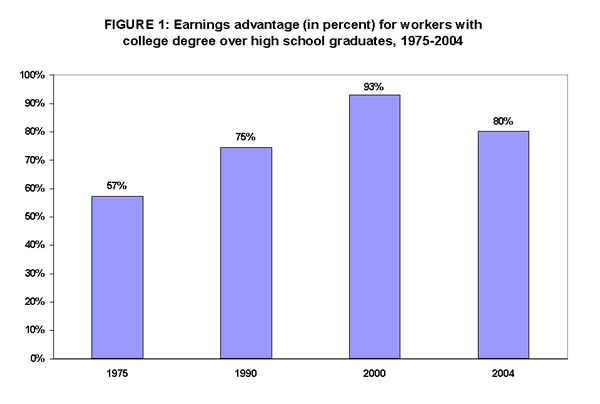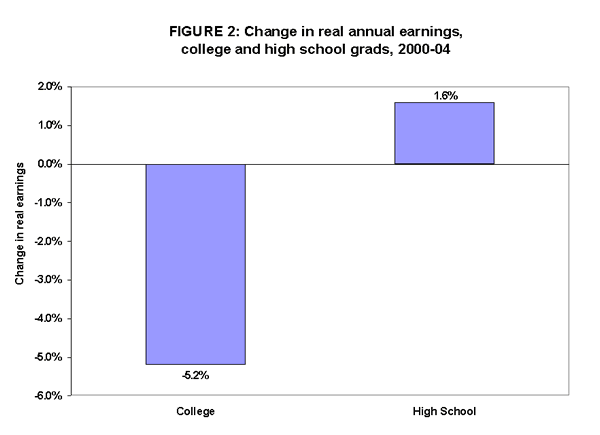See Snapshots Archive.
Snapshot for February 22, 2006.
Earnings premium for skilled workers down sharply in recent years
It is conventional wisdom that earnings have grown faster for college graduates than for high-school graduates. This long-term wage trend has led economists to conclude that the skill demands of American employers have outpaced the supply of skilled workers in the U.S. labor market, thus demonstrating a shortage of college-educated workers.
In his first testimony as Federal Reserve chairman, Ben Bernanke called this increase in the “skill premium” the “most important factor” in explaining the increase in inequality. The new version of the Economic Report of the President (ERP), written under Bernanke as chairman of the Bush Administration Council of Economic Advisers, makes the same argument.
There is, however, a problem with this reasoning: according to the ERP’s own data, the wage premium for skill has contracted sharply over this business cycle. Since 2000, the real earnings of college-educated workers (those with bachelor’s degrees) have fallen quite steeply, while the earnings of high-school graduates have gone up. So according to Bernanke’s and the ERP’s logic, such results would suggest that, since 2000, the supply of college graduates (typically labeled “skilled workers” in this debate) has grown faster than employers’ need for them, and that the supply of high-school graduates (“less-skilled workers”) has not kept up with demand. Obviously, such a trend undermines claims that it’s the skill level of U.S. workers that is the chief factor behind the growth in inequality.
Figure 1, taken from the ERP (Table 2-1), shows the increase in the ratio of annual earnings of college to high-school workers. This ratio increased from 57% to 93% in the 1975-2000 period, a significant increase in the relative earnings of college graduates; it is this trend that has informed much of the debate regarding the alleged “skills mismatch” of the U.S. workforce.

Between 2000 and 2004, however, there is a large decline in this ratio, driven by the 5.2% fall in the real earnings of college graduates over this period (Figure 2 ) that coincided with an increase (albeit modest) in high-school graduates earnings.

Of course, even with this sharp loss, college workers have a significant earnings advantage over those with lower levels of education, and the Bush Council of Economic Advisers is absolutely right to stress the importance of a highly educated workforce.
Nevertheless, policy makers and “futurists” predicting a shortage of skilled labor need to be aware of this reversal in the college premium, especially since it contradicts their explanation of evolving skill demands. It’s possible that the recent results could represent a short-term reversal of a trend that will soon revert back to its prior course (our own research, however, shows that the trend in the college premium flattened in the latter 1990s).1
We could, however, also be witnessing the downward pressure on the earnings growth of college-educated workers due to the offshoring of skilled jobs that had in earlier years commanded a significant earnings premium.2
This week’s Snapshot was written by Lawrence Mishel and Jared Bernstein.
Source: Economic Report of the President, February 2006, authors’ analysis of Table 2-1.
Notes
1. See State of Working America 2004/05 , Figure 2K.
2. See, “ Outsourcing is Climbing Skills Ladder,” Steve Lohr, New York Times, pg. C1, Feb. 16, 2006.
